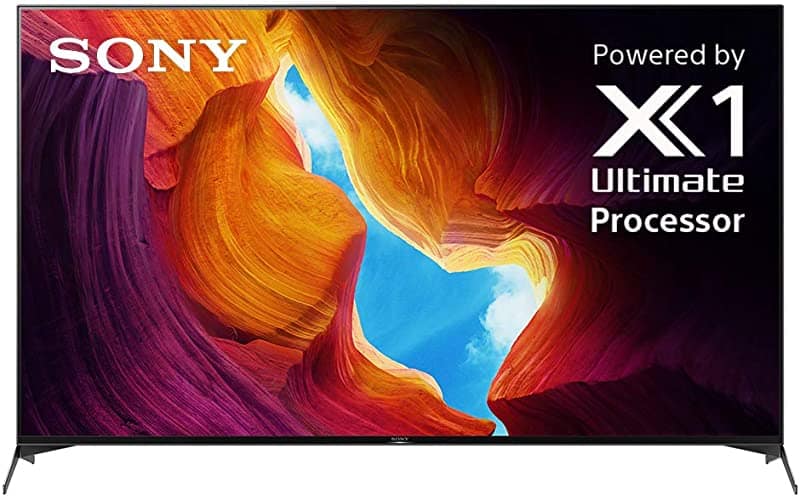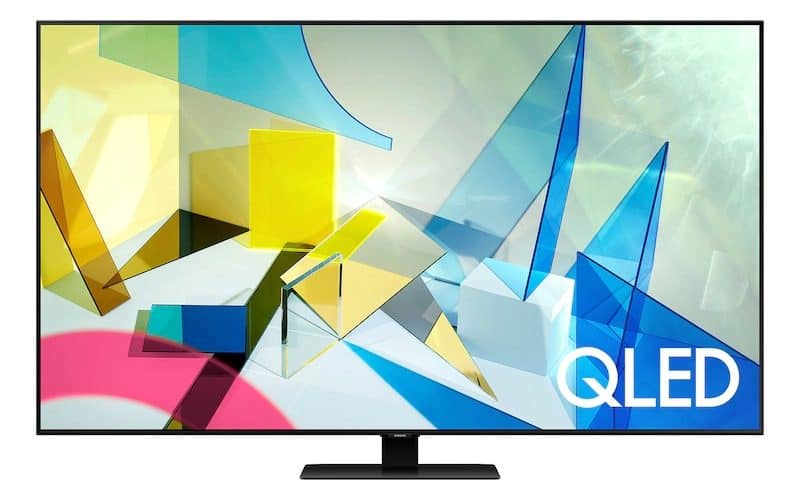The X950H and the Q80T share a significant number of identical performance characteristics. But, as these two models come from two different manufacturers, there are also bound to be discernible differences between them.
Read this detailed Sony X950H vs Samsung Q80T comparison post and learn the key features of these two models so that you can confidently decide which TV is the better choice for you.
Sony X950H vs Samsung Q80T – Quick Comparison
Sony X950H

The newest Sony X950H model greatly improves on its predecessor’s faults to deliver one of the year’s best models. It offers excellent value and impressive processing power for its price range. Here are the X950H’s major pros and cons:
Pros:
- Supports Dolby Vision
- Sony’s leading X1 Ultimate Processor
- Splendid reflection handling
- Excellent price for its performance
Cons:
- No VRR, G-SYNC, or FreeSync
- No HDR10+
Samsung Q80T

The Samsung Q80T is the go-to choice for many buyers looking for a high-grade medium-range TV with fantastic picture quality, low lag, and well-balanced performance features. Let’s take a close look at the most significant advantages and disadvantages of the Samsung Q80T:
Pros:
- Comes VRR, G-Sync, and FreeSync features
- Supports HDR10+
- Fast and easy-to-use Smart TV platform
- Powerful UHD Quantum Image Processor
Cons:
- No Dolby Vision
- Hardly the prettiest TV in its price range
Features Face to Face
Panel Technology
The Sony X950H has a standard LCD panel with direct lighting, meaning that the lights sit behind the screen directly, not at its edges. The Samsung Q80T uses a more advanced panel technology, applying its in-house QLED (Quantum Dot Light-Emitting Diode) technology.
While this QLED panel is still just a type of LED and not a separate kind on its own, it still brings some advantages to the table. More precisely, some of QLED’s most significant innovations include wider viewing angles and deeper blacks.
Image Processor
It’s hard to give either TV the edge in this category simply because both the X950H and the Q80T come with a very powerful processor of their own. The Sony X950H is equipped with the manufacturer’s most capable image processor, the X1 Ultimate, packed with tons of picture-enhancing properties.
On the other hand, the Q80T employs the superb UHD Quantum Image Processor, a great all-around chipset. But, perhaps this processor’s greatest strength is its upscaling capability. The UHD Quantum Image Processor uses AI and machine learning to improve and enhance lower definition content.
Motion Technology
Both TVs provide outstanding motion handling technology, although the Q80T is slightly better in this category. It has a response time of just 10.1 milliseconds. The X950H is not far behind, with a response time of 10.7 milliseconds. These impressive times mean that images always come up crisp and clean with minimal motion blur.
And, although neither TV is flicker-free, the flickering is not noticeable for most users. The Samsung Q80T, in particular, flickers at a very high frequency, so you won’t notice any flickering, no matter what type of content you’re watching.
Picture Quality
While supported resolutions aren’t the only factor contributing to overall image quality, they are undoubtedly crucial. The latter model offers a better range of supported resolutions in a direct Sony X950H vs Samsung Q80T comparison. With that in mind, here’s a detailed overview of the two models’ supported resolutions:
| Resolution | Sony X850H | Samsung Q80T |
|---|---|---|
| 4K/120Hz | No | Yes |
| 4K/60Hz/4:4:4 | Yes | Yes |
| 4K/60Hz | Yes | Yes |
| 1440p/120Hz | No | Yes (Native Support) |
| 1440p/60Hz | Yes (Force Resolution) | Yes (Native Support) |
| 1080p/120Hz | Yes (Native Support) | Yes (Native Support) |
| 1080p/60Hz/4:4:4 | Yes | Yes |
Contrast Ratio / Black Level
The X950H and the Q80T have an equally great contrast ratio. However, compared to most VA panels, these two models have a slightly worse contrast ratio. This is primarily because both the X950H and the Q80T come with a viewing angle improvement implementation. It improves viewing angles at the expense of the overall contrast ratio. These are the Sony “X-Wide Angle” layer and the Samsung “Ultra Viewing Angle” layer.
Local Dimming
The two TVs both come with full-array local dimming. That said, the Q80T is a bit slower in reacting to changes, so it tends to show blooming issues, but not to a great extent. In comparison, the X950H is a bit better at handling blooming around objects, although this doesn’t make a considerable difference in a head-to-head comparison.
Peak Brightness
The Sony X950H has the advantage over the Samsung Q80T in terms of both SDR and HDR peak brightness. Although the Q80T offers above-average performance in both categories, the X950H is simply too good to keep up with. To give you a better perspective of how these two TVs perform in this bracket, here’s a quick comparison table:
| Brightness Values | Sony X950H | Samsung Q80T |
|---|---|---|
| Peak 10% Window SDR Brightness | ∼ 1080 nits | ∼ 710 nits |
| Peak 100% Window SDR Brightness | ∼ 620 nits | ∼ 420 nits |
| Peak 10% Window HDR Brightness | ∼ 1150 nits | ∼ 740 nits |
| Peak 100% Window HDR Brightness | ∼ 690 nits | ∼ 440 nits |
Color
Both models perform about the same in terms of color gamut coverage. They provide impressive coverage of the DCI P3 color space and just okay coverage of the wider Rec. 2020 color space.
With that in mind, the X950H delivers better color volume. While it has some issues displaying brighter blues, it’s more capable of displaying dark and saturated colors thanks to its higher contrast ratio.
Viewing Angle
As both of these models are VA panels, they offer mediocre performance. That said, the Samsung Q80T is slightly better, despite showing brightness loss at slightly lower viewing angles. The Q80T gets the edge in this comparison because it maintains significantly more stable black levels, up to a viewing angle of seventy degrees. This is partly due to Samsungs “Ultra Viewing Angle” layer.
In comparison, the X950H shows black level raises already at around twenty degrees. The X950H comes with Sony’s “X-Wide Angle” layer, but this feature doesn’t significantly improve the viewing angles.
Reflections / Anti-glare
The two TVs offer equally outstanding reflection-handling properties. They both come with a glossy screen finish, meaning that they don’t have any problems with handling bright rooms. The Q80T reflects a tiny percentage less of the total light that hits its screen, while both booths excellently handle indirect reflections. Still, both TVs might create a rainbow-like effect if you place them in a very bright room or opposite a window.
Sound Quality
The X950H and the Q80T both deliver decent sound properties with solid frequency responses. They can get reasonably loud, but neither TV has much bass extension, so you shouldn’t expect room-shaking bass.
Additionally, you might notice some sound compression and pumping when playing audio at higher volume levels. Both models have a room correction feature that tunes the audio according to the room’s acoustics.
Smart TV Platform (Operating System)
The X950H uses the basic Android TV smart platform that most TVs come with. By contrast, the Q80T features Samsung’s Tizen platform, known as one of the smoothest around. For this reason, we give the Q80T a slight edge in this category, primarily because it’s more user-friendly for beginners. Check out the table below to see how these two Smart TV platforms compare:
| OS Features | Sony X950H | Samsung Q80T |
|---|---|---|
| OS Version | Android TV (9.0 Version) | Tizen OS (2020 Version) |
| Time to Change Backlight | 6 seconds | 6 seconds |
| Time to Load YouTube | 2 seconds | 2 seconds |
| HDR Netflix/Youtube | Yes | Yes |
| App Selection/Variety | 9/10 | 9/10 |
| App Smoothness | 9/10 | 9/10 |
| Ease of Use | 7/10 | 9/10 |
Connectivity
Moving away from the fundamental features, connectivity traits are often an essential factor for more tech-savvy buyers. And, when discussing connectivity, three key categories stand out as the most important ones. These are input specifications, voice assistants, and wireless technologies. We’ll go over each of them in that order.
Inputs
As it’s expected from two TVs in the same price range, these two models offer nearly identical input features, especially when it comes to basic connection features. That said, it’s worth noting that the Q80T has a lower input lag across all supported resolutions. Keeping this in mind, let’s take a look at a direct comparison of X950H’s and Q80T’s input selection:
| Input Ports | Sony X950H | Samsung Q80T |
|---|---|---|
| HDMI Ports | 4 HDMI 2.0 Ports | 4 HDMI 2.0 Ports |
| USB Ports | 2 USB 2.0 Ports | 2 USB 2.0 Ports |
| Digital Optical Audio Out | 1 Port | 1 Port |
| Ethernet Port | Yes | Yes |
Voice Assistants
The two TVs come with highly different remotes. The X950H’s remote is filled with dozens of control options, while the Q80T uses a fairly streamlined remote controller that includes only basic control options. That said, both remotes have a built-in microphone that allows you to take advantage of the convenience of voice control.
The X950H’s voice assistant tasks are handled by Google Assistant. The Q80T uses Samsung’s in-house Bixby assistant. Nevertheless, these two assistants have no meaningful difference, as both can carry out most searches and commands and change certain settings.
Wireless Technologies
We’ve noted substantial differences between the two models in several categories above. That said, there’s not much room for differentiation when it comes to wireless technologies, as most TVs in this price range come with the same set of features. These include industry-accepted Wi-Fi (2.4 GHz, 5 GHz) and Bluetooth (4.2 version). Focusing on the latter, this version is advanced enough to support pairing up a mouse, keyboard, stereo audio, or any other low-energy device.
Standout Features
Besides exterior design differences and the features we’ve addressed above, there are some standout features in each of the two models. Most prominently, the Q80T has several gaming features that the X950H doesn’t include. These are G-SYNC, FreeSync, and VRR (Variable Refresh Rate).
Additionally, the two TVs also differ in terms of dynamic input specifications. More specifically, the Sony X950H supports Dolby Vision but unfortunately doesn’t support HDR10+. Opposite to this, the Samsung Q80T supports HDR10+ but doesn’t support Dolby Vision.
Conclusion
Hopefully, this Sony X950H vs Samsung Q80T post has provided you with enough information to point you towards one of these two TVs. If not, we want to leave you off with a few essential pointers to help you decide.
As these two models are in a similar price range with many similar traits, the price shouldn’t be one of your key determinants. Instead, the best way to go about it is to choose between two principal performance categories.
As we’ve highlighted in the previous section, the Q80T has a handful of gaming features that make it a much more favorable choice for video game players. In contrast, the X9v50H comes without any enhanced gaming features but has better peak brightness, local dimming, and black uniformity, making it a better pick for movie enthusiasts.